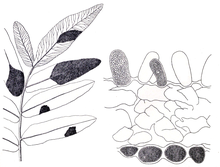| Mixiomycetes | |
|---|---|

| |
| Scientific classification | |
| Domain: | Eukaryota |
| Kingdom: | Fungi |
| Division: | Basidiomycota |
| Subdivision: | Pucciniomycotina |
| Class: | Mixiomycetes R.Bauer, Begerow, J.P.Samp., M.Weiss & Oberw. (2006)[3] |
| Order: | Mixiales R.Bauer, Begerow, J.P.Samp., M.Weiss & Oberw. (2006)[3] |
| Family: | Mixiaceae C.L.Kramer (1987)[2] |
| Genus: | Mixia C.L.Kramer (1958)[1] |
| Species: | M. osmundae
|
| Binomial name | |
| Mixia osmundae (Nishida) C.L.Kramer (1958)[1]
| |
The Mixiomycetes are a class of fungi in the Pucciniomycotina subdivision of the Basidiomycota. The class contains a single order, the Mixiales, which in turn contains a single family, the Mixiaceae that circumscribes the monotypic genus Mixia.[4] Only one species has been described to date, Mixia osmundae; this species was originally named Taphrina osmundae by Japanese mycologist Toji Nishida in 1911.[5] It is characterized by having multinucleate hyphae, and by producing multiple spores on sporogenous cells.[3]
The genus name of Mixia is in honour of Arthur Jackson Mix (1888-1956), who was an American mycologist, who worked at the University of Kansas and used to study of the 'Taphrinales'.[6]
The genus was circumscribed by Charles Lawrence Kramer in Mycologia vol.50 (Issue 6) on page 924 in 1958.[citation needed]
- ^ a b Cite error: The named reference
Kramer1958was invoked but never defined (see the help page). - ^ Cite error: The named reference
Kramer1987was invoked but never defined (see the help page). - ^ a b c Cite error: The named reference
Bauer2006was invoked but never defined (see the help page). - ^ "Mixia C.L.Kramer, 1959". www.gbif.org. Retrieved 6 August 2022.
- ^ Cite error: The named reference
urlMycoBank: Mixia osmundaewas invoked but never defined (see the help page). - ^ Burkhardt, Lotte (2022). Eine Enzyklopädie zu eponymischen Pflanzennamen [Encyclopedia of eponymic plant names] (pdf) (in German). Berlin: Botanic Garden and Botanical Museum, Freie Universität Berlin. doi:10.3372/epolist2022. ISBN 978-3-946292-41-8. S2CID 246307410. Retrieved January 27, 2022.